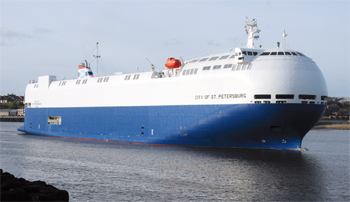Car carriers have traditionally been known as the ‘ugly ships’ of the maritime trades because of their boxy profiles. However, change is coming, as evidenced by the new car carrier City of St Petersburg, which was recently introduced by Nissan to the European trades. Because the ship is being used to transport Nissan’s new LEAF electric cars, it was thought that the vessel should also have fuel-saving features.
The most obvious of the new features is the newbuilding’s semi-spherical forward design, which is expected to achieve a reduction in wind resistance of up to 50 per cent compared to conventional car carrier designs. Based on calculations of an annual navigation rate of 75 per cent under average hydrographic conditions for the North Atlantic Ocean, Nissan engineers have calculated that the new design will achieve a fuel reduction of up to 800 tons annually, which is equivalent to achieving an annual reduction of approximately 2,500 tons of CO2 emissions. However, the rounded design up front means that fewer vehicles can be carried in that position, and this seems to be of greater concern for most car shippers.
Because of this, the majority of car carriers are continuing to be built with a square forward profile, which allows a maximum number of cars to be carried. Nevertheless, the 16.9-knot City of St Petersburg, which off-loaded its first shipment of Japanese-built LEAFs at the Port of Tyne in early February, could be followed by sisterships. Starting in 2013 Nissan will start transporting UK-manufactured LEAF vehicles from its plant at Sunderland to Northern Europe and Russia.


